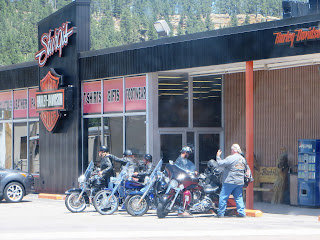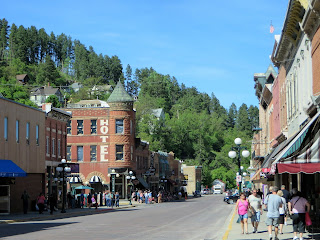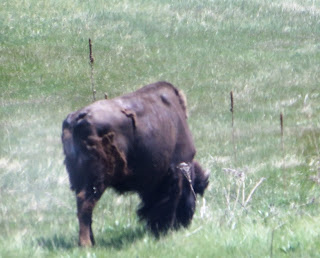Black Hills, South Dakota
Sturgis
Our
sightseeing trip today took us to the northern part of the Black Hills, namely,
Sturgis, Deadwood and Lead.
Our first
stop was Sturgis. Not being bikers,
we were underwhelmed by this small, tired town. Many of the businesses were
closed, and it appeared that they opened only for bike festivities. We were
told that this small town and rural area hosted in excess of one million
visitors during bike week last year. No doubt Sturgis will be a happening kinda
place then.
Our next
stop was the historic, bawdy town of Deadwood,
just a few miles away.
Deadwood
A fan
of HBO’s show by the same name, Alan was keen to learn more about the town, and
what he thought were fictitious characters.
The show, set
in the late 1800s, revolves around Deadwood’s massive gold rush and the unscrupulous
characters attracted by fast fame and fortune. The show features many
historical figures, such as, Seth Bullock, Al Swearengen, Wild Bill Hickock,
Calamity Jane, Wyatt Earp and many more.
This era, I’m sure, was not one of Deadwood’s proudest moments, but it was history, and that can’t be re-written. No surprise, we found no mention of the TV show and any connection with the town.
 Deadwood is
described in South Dakota’s Vacation Guide as “a historic mining town built on
a rowdy history of gold, gambling and gunpowder”.
Deadwood is
described in South Dakota’s Vacation Guide as “a historic mining town built on
a rowdy history of gold, gambling and gunpowder”.Casinos, large and small are still prevalent everywhere in this tourist town.
Strolling the town, we were on the lookout for a place for lunch. We chose the Deadwood Social Club, rated #2 in town by TripAdvisor. Located on Main Street, the second floor historic saloon was promoting al fresco dining on the terrace to take advantage of this perfect sunny afternoon. Lunch and service were excellent.
We are not gamers or gamblers, but could not leave Deadwood without trying our luck at the slot machines. We stopped at a likely looking saloon, where Alan quickly lost his $5 and I won $17 after spending about $2. I immediately quit and cashed out. Winnings were small, but at least I left on the win side.

This picture is for Kian, our youngest
grandson and Beanie Boo fan.
Lead
Our final
stop of the day was Lead. Until its closure in 2002, Lead was home to the
Homestake Gold Mine, the largest gold mine in north America.
In July of 1874, gold was first discovered in the Black Hills by General Custer’s expedition. This discovery signaled the gold rush to the Black Hills area in 1876.
Brothers, Moses and Fred Manuel first discovered gold in the northern Black Hills on April 9, 1876 on what is called the Homestake mine. They discovered an outcrop of ore which was termed as a lead, hence the town name. They sank their discovery shaft in the side of a draw, and in the spring of 1876 took out $5,000 worth of gold. The following year the brothers sold their claim to a trio of mining entrepreneurs for $70,000.
The Homestake mine stayed open until 2001 and was the second largest gold producer in the United States and was once the largest and deepest gold mine in North America. The mine produced 39.8 million ounces of gold for more than a billion dollars. The mine then closed in 2002. Currently the mine is now home to the Sanford Underground Laboratory.
 Alan’s
great, great grandmother’s sister, Margaret Michell Phillips settled in Lead with
her husband John Rapson Curnow. They were both born and grew up in the St. Ives
area of Cornwall, UK, and emigrated to the United States in 1873 when the mines
in Cornwall began closing and employment was scarce. The Curnow’s had 14
children, many of whom worked in the Homestake Mine, as did many of their
children. Given this long line of mine workers here in Lead, we were sorry that
we had so little time at the museum.
Alan’s
great, great grandmother’s sister, Margaret Michell Phillips settled in Lead with
her husband John Rapson Curnow. They were both born and grew up in the St. Ives
area of Cornwall, UK, and emigrated to the United States in 1873 when the mines
in Cornwall began closing and employment was scarce. The Curnow’s had 14
children, many of whom worked in the Homestake Mine, as did many of their
children. Given this long line of mine workers here in Lead, we were sorry that
we had so little time at the museum.

Even though the mine is now closed, Lead appeared to be a much more industrial town than Deadwood. Tourism is important to this area, especially in winter when the population explodes with downhill skiers.

This aerial photo from the internet, courtesy of www.viewamerica.be clearly demonstrates the monstrous size of this pit mine in relationship to the town.
By 5:30 PM
we were out of time and out of energy. We had hoped to visit both the Lead
Cemetery and the Black Hills National Cemetery, but that will have to wait for
another visit.
We have so enjoyed our time in South Dakota, and especially the Black Hills. The western part of the state is so different from the eastern portion. Everyone told us that we would love the Black Hills, and we certainly did.
Until the next time, a domani!
Next stop for us will be Bismarck, North Dakota. We fly out of Bismarck for Pensacola, Florida, where we will spend a week working in our business. Looks like a busy week ahead.
Our final
stop of the day was Lead. Until its closure in 2002, Lead was home to the
Homestake Gold Mine, the largest gold mine in north America.
In July of 1874, gold was first discovered in the Black Hills by General Custer’s expedition. This discovery signaled the gold rush to the Black Hills area in 1876.
Brothers, Moses and Fred Manuel first discovered gold in the northern Black Hills on April 9, 1876 on what is called the Homestake mine. They discovered an outcrop of ore which was termed as a lead, hence the town name. They sank their discovery shaft in the side of a draw, and in the spring of 1876 took out $5,000 worth of gold. The following year the brothers sold their claim to a trio of mining entrepreneurs for $70,000.
The Homestake mine stayed open until 2001 and was the second largest gold producer in the United States and was once the largest and deepest gold mine in North America. The mine produced 39.8 million ounces of gold for more than a billion dollars. The mine then closed in 2002. Currently the mine is now home to the Sanford Underground Laboratory.
We arrived
at the Black Hills Mining Museum, just 25 minutes before closing. Unfortunately,
we missed the last basement tour of a gold mine replica.
 Alan’s
great, great grandmother’s sister, Margaret Michell Phillips settled in Lead with
her husband John Rapson Curnow. They were both born and grew up in the St. Ives
area of Cornwall, UK, and emigrated to the United States in 1873 when the mines
in Cornwall began closing and employment was scarce. The Curnow’s had 14
children, many of whom worked in the Homestake Mine, as did many of their
children. Given this long line of mine workers here in Lead, we were sorry that
we had so little time at the museum.
Alan’s
great, great grandmother’s sister, Margaret Michell Phillips settled in Lead with
her husband John Rapson Curnow. They were both born and grew up in the St. Ives
area of Cornwall, UK, and emigrated to the United States in 1873 when the mines
in Cornwall began closing and employment was scarce. The Curnow’s had 14
children, many of whom worked in the Homestake Mine, as did many of their
children. Given this long line of mine workers here in Lead, we were sorry that
we had so little time at the museum.
The
Homestake Mine was the major employer of the area for many years, and
contributed much to the community, including the Historic, Homestake Opera
House.


Even though the mine is now closed, Lead appeared to be a much more industrial town than Deadwood. Tourism is important to this area, especially in winter when the population explodes with downhill skiers.

This aerial photo from the internet, courtesy of www.viewamerica.be clearly demonstrates the monstrous size of this pit mine in relationship to the town.
By 5:30 PM
we were out of time and out of energy. We had hoped to visit both the Lead
Cemetery and the Black Hills National Cemetery, but that will have to wait for
another visit.
We have so enjoyed our time in South Dakota, and especially the Black Hills. The western part of the state is so different from the eastern portion. Everyone told us that we would love the Black Hills, and we certainly did.
Until the next time, a domani!
Next stop for us will be Bismarck, North Dakota. We fly out of Bismarck for Pensacola, Florida, where we will spend a week working in our business. Looks like a busy week ahead.




















































































